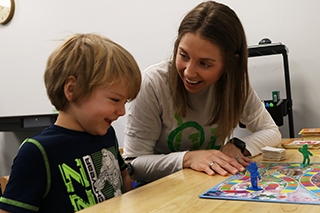Back to School Transitions
Transitioning back to school can be difficult for kids as they are in a new environment, require new routines, manage new expectations, process separation from caregivers, and experience overall unfamiliarity.
As routine changes, so do sleep patters. This greatly influences a child's ability to process their sensory information. causing increased difficulty with socializing, attending, and sitting for longer periods of time.
As routine changes, so do sleep patters. This greatly influences a child's ability to process their sensory information. causing increased difficulty with socializing, attending, and sitting for longer periods of time.
Here are a few ways you can make the back to school transition easier for your kiddo:
1. Establish a sleep routine ASAP!
Developing a regular sleep schedule for a child allows their body to establish a healthy sleep and wake schedule, preventing less fatigue and exhaustion during the day. Using a bedtime routine also helps the body prepare and relax, and teaches children how to fall asleep on their own. As a result, this improves alertness and readiness to learn in the classroom.
The "Ready to Rise" alarm clock on Amazon is a great tool that can help to teach children when it's time to rest and when it's time to get up for the day. Check out the LittleHippo Mella Ready to Rise Children's Trainer Alarm Clock on Amazon.
2. Use verbal and physical forecasting.
Using verbal cues and forecasting helps children to mentally prepare for the transition back to school. The more we can talk to kids about what school will look like with social experiences, classroom activities, lunch time, etc., the more comfortable and prepared they will be. Verbal cues and forecasting help children have less surprises and improve emotionalist when they start school.
3. Use social stories as a visual aide.
Social stories provide a visual guide for children so they know what to expect. This includes images, transitions, social settings, sounds, presence of teachers, etc. The more we can give children a better idea for what the transition to school will look like, the more we can limit unexpected or uncomfortable situations. This can help improve their overall mood at and after school.
Incorporating these strategies can significantly ease the back-to-school transition for your child. By establishing a sleep routine, using verbal and physical forecasting and using social stories as visual aids, you can help your child feel more prepared and comfortable with the changes ahead. Remember, the goal is to create a supportive and predictable environment that reduces anxiety and enhances their ability to thrive in the classroom. With these tools, your child can confidently navigate the new school year and make the most of their learning experience.
Featured Expert
Ashley Roberts, Occupational Therapist here at CP believes in using a client-centered approach to help clients optimize their skill set necessary for reaching their potential.
1. Establish a sleep routine ASAP!
Developing a regular sleep schedule for a child allows their body to establish a healthy sleep and wake schedule, preventing less fatigue and exhaustion during the day. Using a bedtime routine also helps the body prepare and relax, and teaches children how to fall asleep on their own. As a result, this improves alertness and readiness to learn in the classroom.
The "Ready to Rise" alarm clock on Amazon is a great tool that can help to teach children when it's time to rest and when it's time to get up for the day. Check out the LittleHippo Mella Ready to Rise Children's Trainer Alarm Clock on Amazon.
2. Use verbal and physical forecasting.
Using verbal cues and forecasting helps children to mentally prepare for the transition back to school. The more we can talk to kids about what school will look like with social experiences, classroom activities, lunch time, etc., the more comfortable and prepared they will be. Verbal cues and forecasting help children have less surprises and improve emotionalist when they start school.
3. Use social stories as a visual aide.
Social stories provide a visual guide for children so they know what to expect. This includes images, transitions, social settings, sounds, presence of teachers, etc. The more we can give children a better idea for what the transition to school will look like, the more we can limit unexpected or uncomfortable situations. This can help improve their overall mood at and after school.
Featured Expert
Ashley Roberts, Occupational Therapist here at CP believes in using a client-centered approach to help clients optimize their skill set necessary for reaching their potential.
Learn how we can help work with your child to find success.




Comments
Post a Comment